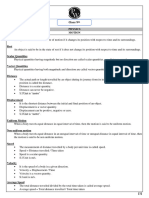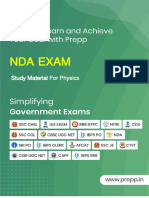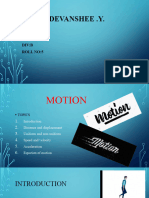Class 9 Science – Chapter 8: Motion
(Notes)
1. Motion
Motion is the change in position of an object with time.
A body is said to be at rest if it does not change its position with time.
2. Types of Motion
1. Translational Motion – Motion in a straight line (e.g. car on a road).
2. Rotational Motion – Motion around a fixed axis (e.g. fan blades).
3. Oscillatory Motion – To and fro motion (e.g. pendulum).
4. Circular Motion – Motion in a circular path (e.g. earth around the sun).
3. Distance and Displacement
Distance: Total path covered (Scalar)
Displacement: Shortest distance from initial to final position (Vector)
Distance is always positive. Displacement can be positive, negative, or zero.
4. Uniform and Non-Uniform Motion
Uniform Motion: Equal distance in equal time.
Non-Uniform Motion: Unequal distance in equal time.
5. Speed and Velocity
Speed = Distance / Time (Scalar)
Velocity = Displacement / Time (Vector)
Uniform velocity = Constant speed in straight line
Variable velocity = Direction or speed changes
6. Acceleration
Acceleration = (v - u) / t
SI unit: m/s²
Positive acceleration: Speed increases
Negative acceleration (Retardation): Speed decreases
�7. Graphical Representation of Motion
a. Distance-Time Graph:
- Straight line → Uniform speed
- Curved line → Non-uniform speed
b. Velocity-Time Graph:
- Horizontal line → Uniform velocity
- Sloped line → Uniform acceleration
8. Equations of Motion (For Uniform Acceleration)
1. v = u + at
2. s = ut + ½ at²
3. v² = u² + 2as
Where:
u = initial velocity, v = final velocity, a = acceleration,
s = distance travelled, t = time taken
9. Uniform Circular Motion
Object moves in a circle with constant speed.
Velocity changes due to direction.
Acceleration is towards the center – called centripetal acceleration.
Key Concepts for Exam
- Difference between distance and displacement
- Scalar vs Vector quantities
- Numericals using motion equations
- Interpreting motion graphs
- Real-life case studies on motion

























































